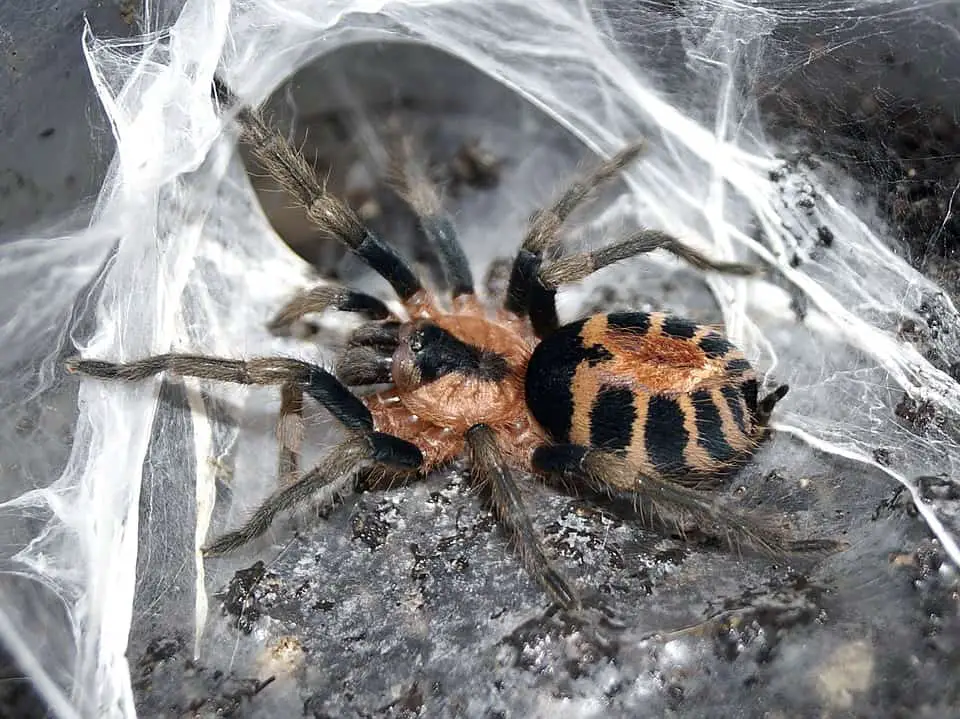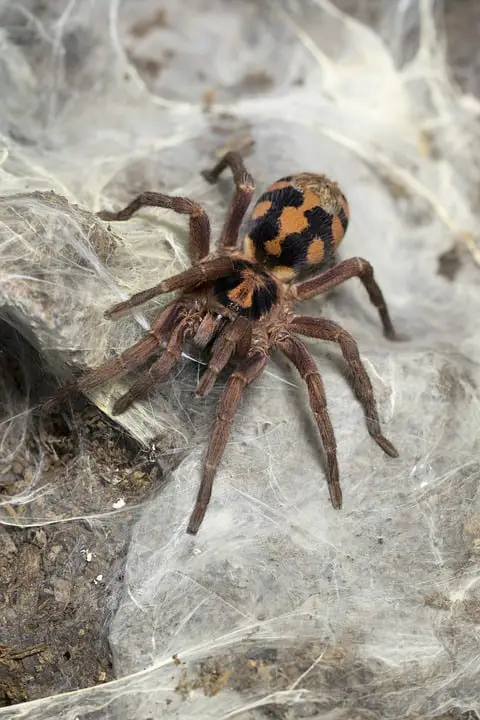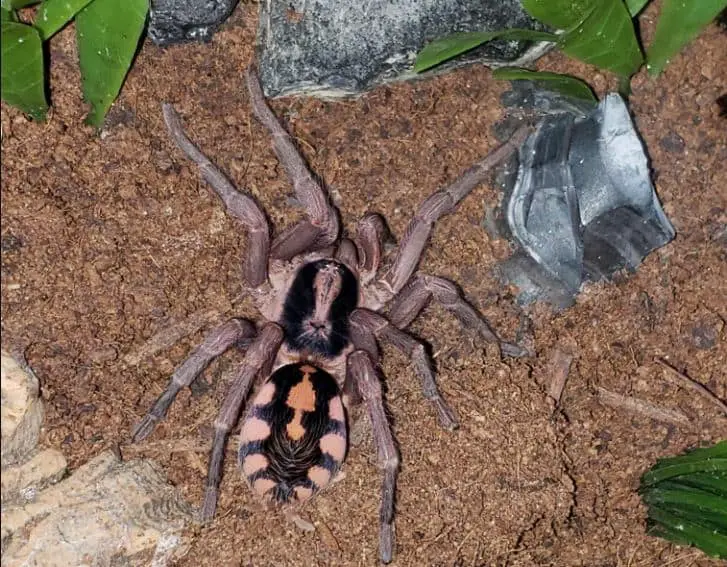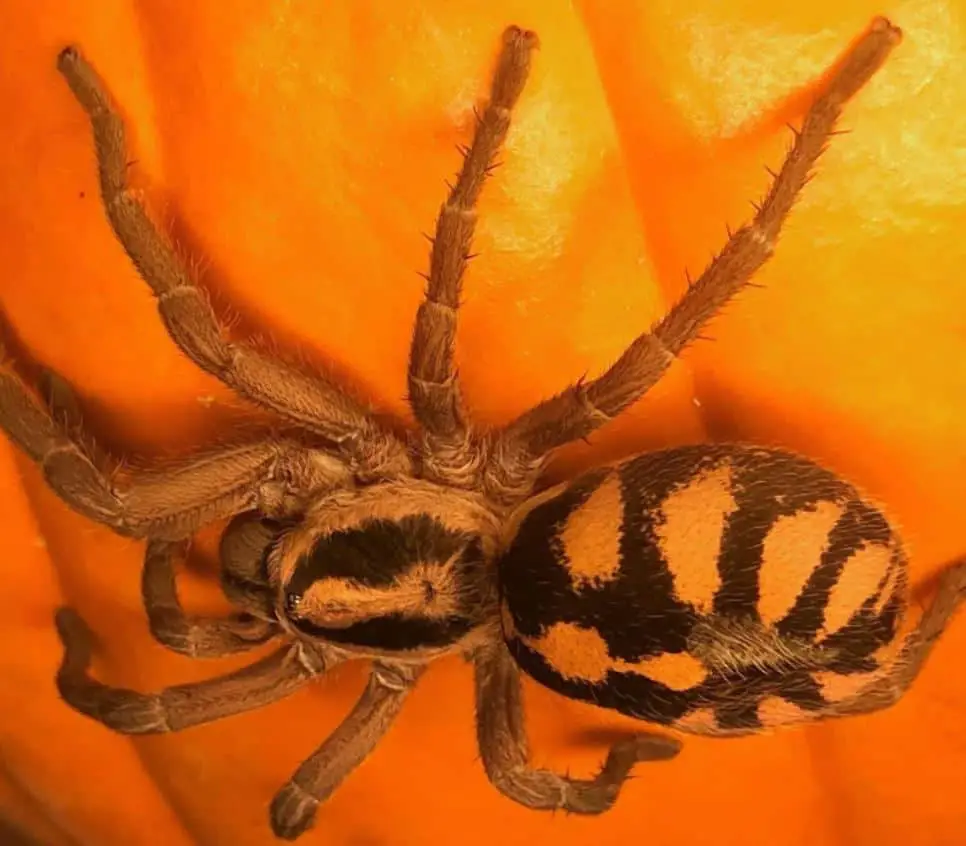The Pumpkin Patch Tarantula (Hapalopus sp Colombia) is a terrestrial dwarf tarantula known and coveted for its beautiful orange and black color patterns. It’s native to the Columbian regions, so it’s sometimes also known as the Columbian Pumpkin Patch. it comes in two varieties: Groot & Klein, these are the Dutch words for big and small, which refer to their respective sizes.
Due to its striking colors, this tarantula is highly sought after by enthusiasts. However, before you pull the trigger on adding this species to your collection, there are some things you should know about them. We’ve compiled all the most crucial information in one place to give you the ultimate care guide for the Pumpkin Patch Tarantula.

Pumpkin Patch Tarantula Care Sheet
| Species Name | Hapalopus sp Colombia |
| Family Name | Theraphosidae |
| Common Name | Pumpkin Patch Tarantula, Colombian Pumpkin Patch |
| Category | New World |
| Type | Terrestrial |
| Native Location | Colombia |
| Leg Span | Groot: 4 inches (10 centimeters), Klein: 2.5 inches (6 centimeters) |
| Growth Speed | Fast |
| Urticating Hairs | Yes |
| Social | Solitary |
| Diet | Insects: crickets, roaches, mealworms, etc |
| Temperature | 75 to 80 Fahrenheit |
| Humidity | 70-75% |
| Life Expectancy | Females, 10 years. Males, 3 years. |
| Recommended Experience Level | Beginner-friendly |
| Minimum tank size | 1 to 2.5-gallon enclosure. |
Pumpkin Patch Tarantula Overview
Appearance And Varieties

There are two types of Pumpkin Patch Tarantulas, the Groot, and the Klein. Both varieties are attractively patterned in orange and black, with the difference between the two coming down to size.
Both variants are quite small since this is a dwarf species, but the “Groot” variety is the larger version, growing about 3-4 inches, while the Klein usually only grows as large as 2.5 inches.
Regardless of the variant, males are a little smaller than females, which is typical for tarantulas. To determine whether it’s a male or a female you can wait until the first molt and then take a look at the cast-off exoskeleton.
Price
Pumpkin Patch Slings will go for about $30-40. Grown tarantulas will cost an average of $80 for males, while the females can cost around $100. The reason why males are cheaper than females is that females live much longer.
Of course, there are also some other costs when taking care of a spider. Luckily, these are quite low. Their enclosure, food, and water are all quite cheap.
Behavior & Temperament

Pumpkin Patch tarantulas are relatively lively; you will see them moving around the terrarium a lot. However, they are a little skittish and will bolt into their dens when disturbed.
They’re often not very defensive and prefer to run away from things that they perceive as dangerous rather than stand and fight. Of course, if they feel like they are threatened and have nowhere to run they will defend themselves.
The tools this spider uses to defend itself are its urticating hairs which it releases in the air as a defense mechanism. Make sure that you avoid getting these in your eyes, as that can do serious damage.
They can also bite and have a mild venom. This venom is typically not dangerous to humans, unless you’re allergic, due to its low toxicity, but it’s still not pleasant.
They’re also quite fast, so make sure to be careful when opening their tank during feeding and cleaning to prevent escape.
This spider is also an avid webber and will create beautiful web tunnels.
Caring for a Pumpkin Patch Tarantula
A Pumpkin Patch Tarantula is relatively easy to care for; you just need to provide them with a proper tank and enough food.
Tank Size
Since these spiders like to burrow, you need to keep them in a tank that is at least one and a half to two gallons and can have at least 3 to 4 inches of substrate.
Give them a tank where the width is about three times their leg span, and the height of the tank should be no more than 1.5 times the tarantula’s leg span. So a full-grown tarantula of about 4 inches should have a tank that is 12 inches wide and around 12 inches tall.
Substrate
It is best to use a substrate with a high moisture retention level. A good mix would be moist coconut fiber and peat moss, and you can also add some sphagnum moss. As we mentioned, these tarantulas like to burrow, so make sure that there is at least 3 to 4 inches of substrate in the tanks to give them adequate space to burrow.
Temperature
Keep the temperature at around 75 to 80 degrees Fahrenheit (25 to 28 Celsius). In areas with a temperate climate, there is no need to worry about heating your tarantula’s tank. However, if you live in an area with a colder climate, you might want to add some supplemental heat.
Humidity
Your PPT will be happy in a tank with humidity between 70 and 75%. To keep the humidity at adequate levels it’s important that you use adequate substrate, as mentioned above. On top of that, it’s a good idea to use an oversized water bowl and fill it up often. The evaporation will increase the moisture in the air. Some owners also choose to mist the enclosure.
Accessories
You should provide your Pumpkin Patch Tarantula with a small shallow water bowl and some material that they can use as a hide, such as cork bark, rocks, sticks, or even small plants.
Social
This tarantula is solitary and should not be housed with others. In nature, they only meet with other members of their species when it’s time to mate. The situation should be kept the same in captivity since these animals can be quite territorial.
In addition, tarantulas might be relatively friendly towards humans, but they do not crave human attention as some other pets do. For that reason, it’s not necessary to handle them or play with them or anything like that. You can handle them, but it’s not something that the spider needs to thrive.
Feeding your Pumpkin Patch Tarantula

Pet Pumpkin Patch Tarantulas are usually fed insects such as crickets, fruitflies, and cockroaches, though they will also eat waxworks and mealworms. They can eat both pre-killed insects and live ones, though they prefer to hunt and eat live ones.
Feed spiderlings around 2-3 times a week. Juvenile and adults can be fed once a week. Don’t feed them for about 2-3 days after a molt because their fangs need time to harden.
Make sure that you remove uneaten food within 24 hours of introducing it to the tank. This is especially important if you feed your tarantula live prey, as live prey wandering around their tank can stress out or even endanger your eight-legged friend.
As far as drinking goes, tarantulas only drink water. All they need is a water bowl with fresh water. Make sure that you renew the water frequently.
Health & lifespan
The Pumpkin Patch tarantula is a relatively hardy species that is relatively easy to care for. In captivity, they do not have much to fear aside from possible mites, parasites in their food, or dehydration. Luckily, these problems are quite easy to prevent and fix.
Because of this, they can easily fulfill their lifespan of 3 years for males and 10 years for females.
Breeding Pumpkin Patch Tarantulas
You can breed female Pumpkin Patch Tarantulas after they reach two years, and a male will be ready for breeding after one year.
Feed the female before introducing a male into her tank. Be ready to remove the male after mating, though a well-fed female should just retreat to her burrow after the mating.
After a month, you should see the female carrying an egg sack. After 3 or 4 weeks, remove the egg sack, and the spiderlings should begin to hatch shortly afterward.
Pumpkin Tarantula Quick Facts
- Young Pumpkin Patch Tarantulas will molt around every month, but once they reach adulthood, they will only molt once a year.
- Males are considered adults upon reaching one year, while a female reaches adulthood in two years.
- Females live longer than males. A female can live for as long as ten years, while a male will usually only live for three to four years.
- A good rule of thumb to help you decide how much food to offer your tarantula, don’t provide any insect that is bigger than the size of their abdomen.
- A fall can seriously injure or kill your tarantula so try not to handle them too much or let them climb too high.
- The species is not formally described yet by science
Final words: Is A Pumpkin Patch Tarantula Suitable For You?
The Pumpkin Patch Tarantula is a good choice for beginners, as it is a reasonably hardy species that is easy to care for. The bright colors and attractive patterns make them a great addition to any collection, and they are inexpensive to acquire and keep.
They’re considered a docile species, but you should refrain from handling them as they are skittish and spook easily. They are really more a display spider than a handling spider.
These spiders are not known to be aggressive, and they are more likely to run and hide rather than attack when disturbed. They also don’t have much venom, so a bite from a Pumpkin Patch Tarantula will hurt but shouldn’t cause any significant problems unless you’re allergic. Their urticating hairs are also considered less irritating than those found in other tarantula species; just make sure you practice proper hand hygiene to keep these hairs from getting in your eyes and mouth.
- How Long Do American Eskimo Dogs Live? Important Factors and Care Tips - September 29, 2023
- Do American Bulldogs Need Grooming? Essential Tips and Care Guidelines - September 29, 2023
- Do Bengal Cats Enjoy Playing? Essential Tips for Keeping Them Active - September 29, 2023